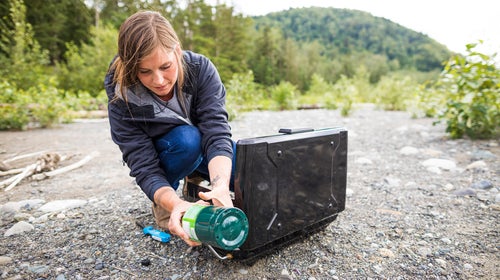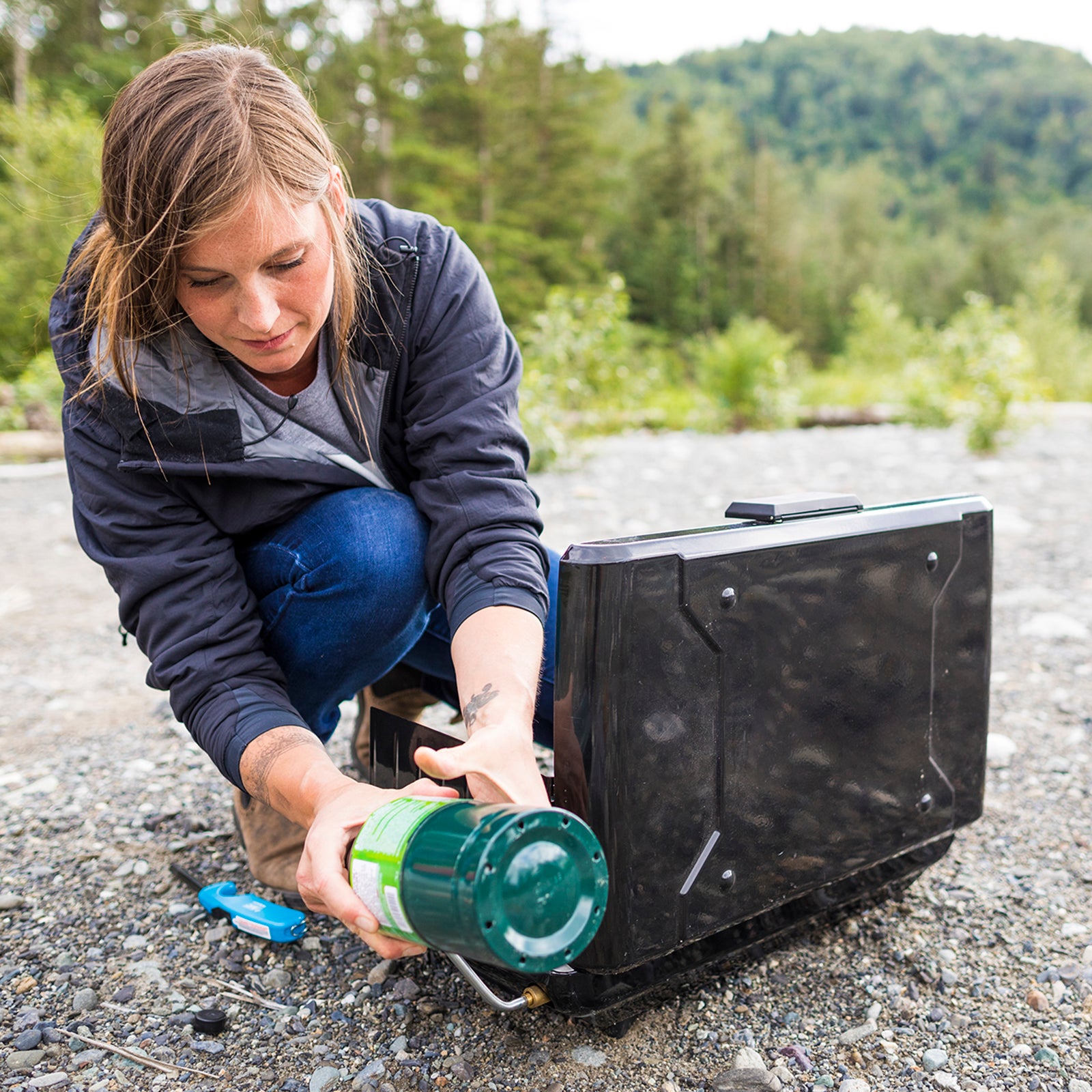Every fall, Danny BaschÔÇÖs┬áteam hooks a squat 14-foot trailer┬áup to a white National Park Service truck and wheels it out of storage. A┬ágenerator mounted atop the trailer burps to life, and BaschÔÇÖs employee┬ápicks up six green one-pound propane canisters from a pile collected throughout the┬áyear from park visitors. The canisters are slid individually into metal braces, and a series of buttons and levers are pressed to suck out any excess propane.┬áThen the bottles are dropped into a hopper, where theyÔÇÖre crushed flat and punched full of holes, falling into the bottom of the trailer to┬ájoin what will eventually be┬á3,000 similar steel hockey pucks.
It takes BaschÔÇÖs Rocky Mountain National Park┬áfacilities┬áteam about a week to process the few thousand bottles thrown away in the park over the prior year. Anyone who has spent any time camping or barbecuing is familiar with the one-pound cylinders that the Propane Bottle Recycler (PBR) processes: universal, disposable, and cheap, theyÔÇÖre used for┬áeverything from lanterns to camp stoves to the torches wielded by pipe fitters to mini flamethrowers that give your steak the perfect sous vide searing.┬áBut unlike the larger 20-pound tanks hooked up to your backyard grill, the smaller canisters arenÔÇÖt refillable. Instead, unless theyÔÇÖre left at one of a half dozen┬ánational┬áparks, like Rocky Mountain, they end up in the landfill, or worse, a┬árecycling area.
ÔÇťTheyÔÇÖre basically little bombs,ÔÇŁ says Brad Fimrite, president of , a private company that handles toxic waste in the northern Rockies. If the bottles are caught in machinery or crushed, any remaining flammable gas inside could explode. And for recyclers, venting and opening the canisters is generally too labor-intensive to make scrapping the one pound of steel in the bottles cost-effective. The result is that most recyclers turn away┬áthe bottles entirely. While some communities feature hazardous-waste facilities that might process them, they are rare and are almost never include curbside pickup, which means very few avoid the landfill.┬á
In 2012, after an analysis of the parkÔÇÖs solid waste, BaschÔÇÖs team was just beginning to realize the problem the canisters were causing. ÔÇťOne of the big things that we identified was how many of these we had,ÔÇŁ he says.┬áPutting out milk crates in the parkÔÇÖs campgrounds to separate the propane bottles from the rest of the waste backfired when they realized they couldnÔÇÖt recycle them normally. ÔÇťWe hit a brick wall,ÔÇŁ says Basch.┬áÔÇťBut at the same time, we heard about this Bottle Recycler trailer.ÔÇŁ
While some communities feature hazardous-waste facilities that might process the bottles, they are rare and almost never include curbside pickup, which means very few avoid the landfill.
For Fimrite, whose company handled the hazardous waste of Yellowstone in┬á2005, finding a solution to that parkÔÇÖs growing propane-canister problem seemed relatively simple for him┬áand his friend,┬ámechanic Wayne Wildon, to solve. While Fimrite worked with the Park Service to figure out exactly what it┬áneeded, Wilson cobbled the first PBR┬ámachine┬átogether in his shed. ÔÇťWe built the first one, and it worked like a charm,ÔÇŁ says┬áFimrite. It was seven years before Basch heard about the machine at┬áYellowstoneÔÇÖs from his colleagues, and he reached out to Fimrite┬áand put in his order.
Today┬áthere are only eight iterations of the PBR in operation: alongside Yellowstone and Rocky Mountain National Parks, Yosemite, Bryce Canyon, Joshua Tree, and Shenandoah have units (some of which are loaned┬áout to nearby parks), as does an EPA facility in Florida and CanadaÔÇÖs Ministry of Natural Resources in Thunder Bay, Ontario.
Typically built to order in WilsonÔÇÖs shed in six to eight weeks at a cost of upward of $62,000, Fimrite and Wilson have tweaked the design slightly unit by unit based on each customerÔÇÖs needs. But the premise remains the same: suck the propane out of the bottle, crush it, and punch two holes in the side in an effort to make it amply clear to recyclers and scrap dealers that the canisters are empty and safe. Any excess propane removed from the bottle goes into storage tanks mounted on the trailer, which not only┬árun the generator to operate the compressor and crusher┬ábut can also be carried away and added to the parkÔÇÖs propane stores for use in rangersÔÇÖ stoves and other fuel-dependent equipment. At Rocky Mountain National Park, the load of crushed bottles is then shuttled down to a recycler in the Front Range of Colorado.
The PBR isnÔÇÖt the first attempt at solving the issue of propane-bottle recycling. In the past, Coleman, one of the largest manufacturers of one-pound propane cylinders, developed a tool that would open the bottles and vent out any remaining propane,┬ábut the idea of simply releasing flammable gas never caught. Plus, it still wasnÔÇÖt obvious enough to recyclers that the bottles were empty, so the program was discontinued. More recently, the brand Flame King has developed that can be refilled from a larger tank, and Ignik just┬áreleased the┬áfive-pound refillable Gas Growler, which┬ácan be refilled at a station like you would┬áwith┬áa 20-pound tank. Fimrite thinks reusable┬ábottles could help but probably wonÔÇÖt solve the issue as a whole. ÔÇťMost people like the ease of throw-away stuff, unfortunately,ÔÇŁ he says.
At the same time, expanding the PBRÔÇÖs use is low on FimriteÔÇÖs priority listÔÇöhis real job is running his hazardous-waste company. Rather than marketing and pitching the machines, he relies on Google searches and word of mouth to advertise them. ItÔÇÖs his side business, so he only builds units when heÔÇÖs approached by individuals at other parks. And because there hasnÔÇÖt ever been a top-down push for these from the Park Service, itÔÇÖs been handled almost exclusively by various employees, who are mostly acting out of concern for their own parks.
As a result, itÔÇÖs been six years since the last one was purchased. According to the Park Service, many parks arenÔÇÖt aware the recyclers exist. ÔÇťIt hasnÔÇÖt taken off super well,ÔÇŁ says Fimrite, who guesses that the parksÔÇÖ already-strapped budgets┬áhave┬ácontributed to the slow takeoff, too.
Now, with Fimrite and Wilson nearing retirement, Fimrite is waiting for someone else to step up. ÔÇťHopefully someone takes it to the next level, because the world needs it,ÔÇŁ he says, leaving the door open for a brand like Coleman, Flame King, or Ignik┬áto pick up where they leave off.


